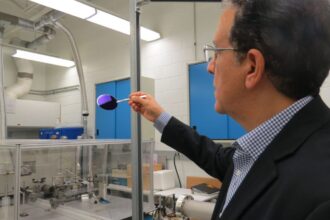A group of scientists from the Institut national de la recherche scientifique (INRS) in Canada has made an important breakthrough in the field of solar energy. They have created a new material called Ti₄O₇, a special form of titanium oxide, that can directly turn sunlight into heat with very high efficiency.
This discovery could help in developing better clean energy technologies for homes, industries, and environmental use. The results of their work have just been published in Nature-Scientific Reports journal.
Before this new research, Ti₄O₇ was only made in powder form, which made it hard to use in real-world products. But now, the researchers have found a new way to produce this material as a thin film that can be applied to many surfaces like glass, metal, and silicon.
They used a method called magnetron sputtering, which is a type of plasma-based technology. This allowed them to create ultra-thin and smooth coatings of Ti₄O₇ on different materials. This technique is also safe, energy-efficient, and can be used for large-scale production.
The biggest success of this research is that these thin films can absorb sunlight and change it into heat very effectively. This ability is very useful in solar thermal systems, which use the sun’s heat instead of turning it into electricity. With Ti₄O₇ films, it is now possible to build better and cheaper systems for solar water heating, desalination, or even heating buildings through smart windows.
This research is also important because, for the first time, scientists have shown the link between how much sunlight the Ti₄O₇ material absorbs and how much heat it produces. Understanding this connection will help improve the performance of solar materials in the future.
The thin films not only absorb sunlight well but also have excellent electrical conductivity and are very resistant to corrosion. These two properties make them ideal for long-term use in harsh conditions, such as seawater desalination plants or industrial water treatment systems.
The scientists believe that this new material can be used in many different areas. One possible use is in smart windows that can help save energy in buildings. These windows could keep heat inside during the winter by using sunlight, which would reduce the need for electric or gas heaters. This would not only cut down on electricity bills but also lower carbon emissions.
Another important use is in solar-powered water desalination. In many parts of the world, clean drinking water is hard to find. With Ti₄O₇ coatings, solar heat can be used more efficiently to remove salt from seawater, helping to provide fresh water in dry or coastal regions. The same material can also be used in special anodes for water purification. These anodes, when placed in water treatment plants, help to clean polluted water by removing harmful substances.
There is also great potential in using Ti₄O₇ for clean fuel production. The material could help in the solar-powered creation of hydrogen and ammonia. Hydrogen is a clean fuel of the future, and ammonia is widely used in fertilizers. Making both with solar heat instead of fossil fuels would help the environment and support green industry goals.
What makes this discovery even more promising is the fact that the production method is environmentally friendly and cost-effective. The magnetron sputtering technique avoids toxic chemicals and works at lower temperatures compared to older methods. This means it can be safely used in factories without harming workers or the environment. It also means that the technology can be scaled up and used in large projects, not just in the lab.
Dr. Jérémie Gagnon, one of the lead scientists on the project, said this new development brings solar innovation closer to daily life. He said that Ti₄O₇ is not only a powerful new material but also easy to produce in useful forms. He believes that this technology could be used in everything from smart windows to advanced solar devices that help clean water or produce fuel.











